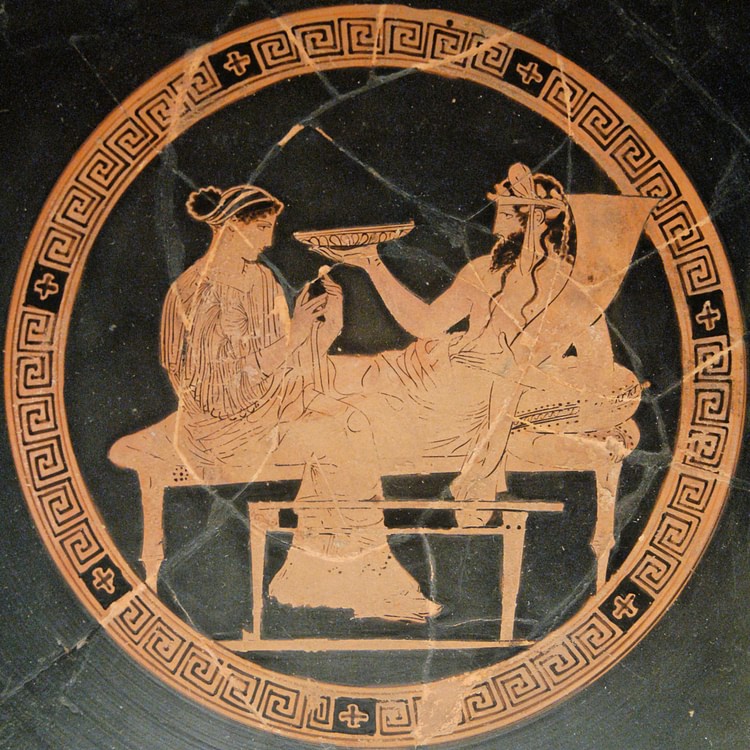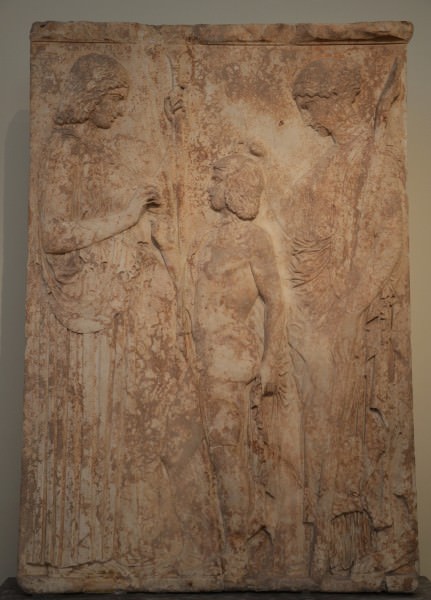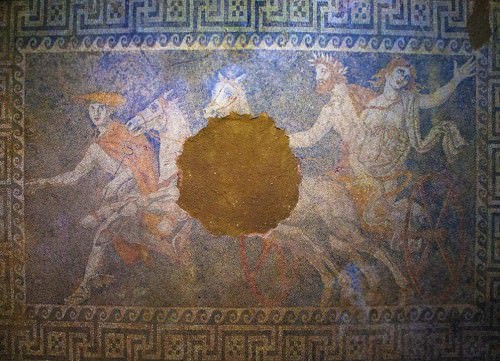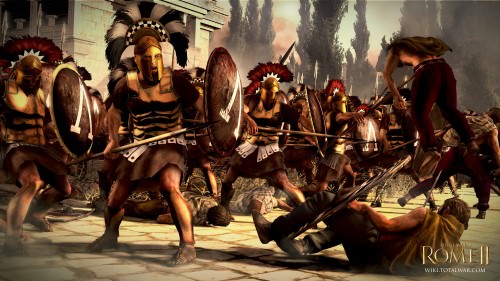Persephone › Lysander » Ancient origins
Articles and Definitions › Contents
- Persephone › Who Was
- Lysander › Who Was
Ancient civilizations › Historical and archaeological sites
Persephone › Who Was
Definition and Origins

Persephone (aka Kore) was the Greek goddess of vegetation, especially grain, and the wife of Hades, with whom she rules the Underworld. An important element of the Eleusinian Mysteries and the Thesmophoria festival, the goddess was worshipped throughout the Greek world and frequently appeared in all forms of Greek art.
KORE - PERSEPHONE - PROSERPINA
In many ancient cults the goddess, along with her mother Demeter, is associated with vegetation and grain. In this guise she is most often referred to as Kore, signifying both 'daughter' and 'maiden'. In Greek mythology, the goddess, as wife of Hades, is the Queen of the Underworld and takes her other name, Persephone. In this guise, she was seen as a protectress in the after-life, although Hesiod repeatedly describes her as 'dread Persephone' in his Theogony. In various other myths, Persephone is the mother of Dionysos (with Zeus, who is also her father) and squabbles with Aphrodite for the attentions of devilishly handsome Adonis, the two settling to share the famous lover in split shifts. In the Roman world the goddess was known as Proserpina.
PERSEPHONE & HADES
According to mythology, Hades, god of the Underworld, fell in love with beautiful Persephone when he saw her picking flowers one day in a meadow. The god then carried her off in his chariot to live with him in the dark Underworld. In some accounts, Zeus had given his consent to the abduction, the location of the crime being traditionally placed in either Sicily(famed for its fertility) or Asia.
Meanwhile, Demeter searched the earth for her lost daughter and though Helios (or Hermes ) told her of her daughter's fate, she, nevertheless, continued her wanderings until she finally arrived at Eleusis. It was here, disguised as an old woman, that the goddess cared for Demophon (or Triptolemos, who would later give the gift of corn to humanity and teach farming), the only son of Metaneira, the wife of Keleos, king of Eleusis. To reward the family for their kindness, Demeter set about making Demophon immortal by placing him on a fire every night. However, when Metaneira saw this, she raised an alarm. In response, Demeter revealed her true identity and demanded a temple be built in her honour. This was the beginning of the celebrated sanctuary of Eleusis.
PERSEPHONE COULD HAVE BEEN RELEASED FROM HADES IF SHE HAD NOT EATEN ANYTHING IN THE UNDERWORLD DURING HER CAPTIVITY, BUT AT THE LAST MOMENT, HADES GAVE HER A POMEGRANATE SEED.
Once the temple was completed, Demeter withdrew from the world and lived inside it; at the same time, she created a great drought to convince the other gods to release Persephone from Hades. As the drought claimed ever more victims, Zeus finally sent Hermes to persuade Hades to release his ill-gotten bride. Before giving her up though, the wily Hades put a pomegranate kernel in the girl's mouth, knowing its divine taste would compel her to return to him. In other versions of the myth, Persephone could have been released if she had not eaten anything in the underworld during her captivity, but at the last moment, Hades gave her a pomegranate seed. Finally, as a compromise, it was decided that Persephone would be released but that she would have to return to Hades for one-third of the year (or in other accounts one-half).
SIGNIFICANCE OF THE MYTH
The story of Demeter and Persephone was perhaps symbolic of the changing seasons and the perennial change from life to death, to life once more, or in other words, the changes from summer to winter and the return of life in spring as seen in agriculture. The cycle became one of the rituals of the sacred Eleusinian mysteries; indeed, the symbols of the cult were ears of corn and a torch - reminding of Demeter's search for Persephone and that the rituals were carried out at night. As all initiates were bound by a sacred oath not to reveal the details of the Mysteries, they have to this day remained just that, a mystery.

Eleusinian votive relief
Another interpretation of the Persephone myth may be that it represents when the Greeks stored their grain underground for part of the year in order to protect it from summer heat. In favour of this argument is that in Greece ’s climate seeds are sown in the autumn and quickly germinate to grow throughout the winter time. Therefore, Persephone's time in Hades would not equate with winter in the agricultural season but, rather, with summer. Whatever the exact significance, the association between Persephone and agriculture is firmly established in rituals, literature, and ancient art. Finally, the myth of Hades' abduction may also reference the Greek practice of girls marrying in their early teens, a loss to their mothers as Persephone was to Demeter.
OTHER CULTS OF PERSEPHONE
The cult of Persephone was especially strong in Sicily and southern Italy, and besides the Eleusinian Mysteries at Eleusis there were sanctuaries to the goddess across the Greek world, most notably at Locri Epizephyrii, Mantinea, Megalopolis, and Sparta. Here annual festivities celebrated Persephone's marriage and her picking of flowers. The Thesmophoria was a Greek-wide celebration of the goddess and her mother. Exclusive to women, it was held annually before the sowing period when sacrifices were made and putrefied pig's remains were mixed with the seeds. Persephone, in her guise as Queen of the Underworld, was often appealed to in curse tablets and on the inscribed gold leaves buried with the dead followers of Orphism which gave instructions on how to conduct themselves in the after-life.

Persephone Mosaic, Amphipolis
PERSEPHONE IN ART
Persephone rarely appears in art before the 6th century BCE, and then she is usually shown with Demeter; often both wear crowns and hold a torch, sceptre, or stalks of grain. A famous 5th-century BCE relief slab from Eleusis depicts Demeter and Persephone (holding a torch) either side of Triptolemos. It is on permanent display in the National Archaeological Museum in Athens. On Attic red-figure pottery throughout the Classical period, Persephone is often shown seated on her throne in Hades.
Frescoes in the 4th-century BCE royal tomb at Aegae (Vergina) in Pieria, Macedon show Hades abducting the goddess and explain the popular 'Tomb of Persephone' label. A recent spectacular find is the large pebble mosaic, measuring 4.5 by 3 metres from the Hellenistic tomb at Amphipolis, which again depicts the god Hades abducting Persephone in a chariot led by Hermes. Persephone's abduction by Hades was a popular subject in Roman sculpture too, especially on sarcophagi, and continued to be so for 18th and 19th-century oil painters.
Lysander › Who Was
Definition and Origins

Lysander (d. 395 BCE) was a Spartan statesman and general who famously defeated the Athenian navy at the Battle of Aigospotamoi in 405 BCE, which finally won the Peloponnesian War. Lysander gained a reputation for a fiery personality, daring strategies, and a ruthless treatment of prisoners and subject cities. The Spartan's harsh policies in wider Greece in the aftermath of the Peloponnesian War ultimately brought his downfall. Unpopular at home and across Greece, he was killed by a Theban force in 395 BCE in the first year of the Corinthian Wars. Lysander is the subject of one of Plutarch ’s Livesbiographies.
EARLY LIFE
Not very much is known about Lysander's early life except that his father was Aristokritos and that he belonged to the Heraclid clan of Sparta. We also know that he was relatively poor and needed financial help to complete his education and military training. When he became an admiral ( nauarchos ) in c. 408 BCE, Lysander was given the task of persuading the Persian king Cyrus the Younger to give aid to the Spartans in their war against Athens and her Delian League allies. In this mission, and in gaining Cyrus ' friendship too, he was successful.
THE PELOPONNESIAN WAR & NAVAL VICTORIES
Lysander's first notable victory was at the naval Battle of Notion on the coast near Ephesos in c. 407 BCE. There he defeated Alcibiades ' deputy Antiochos with a superior deployment of his ships. The loss would cause the Athenians to dismiss their great general Alcibiades, charged with neglecting his duty in allowing a subordinate, and only a helmsman at that, in command of the fleet.
Lysander then established his reputation for daring tactics at the Battle of Aigospotamoi on the Hellespont in 405 BCE. He had twice deliberately refused to engage his fleet of Persian-funded 200 ships with the larger Athenian fleet, and so they believed the Spartan was battle-shy. On the fifth day, the Athenians were resting with their ships pulled on the shore, which was a necessary procedure to periodically dry out the hulls and prevent water-logging of ancient ships. Lysander chose this moment to attack and overwhelmed the enemy, only eight Athenian ships managed to escape the debacle. The Spartan then executed his 3,000 prisoners without mercy. Victory for Sparta finally brought an end to the Peloponnesian War which had started back in 431 BCE.
IN A VAIN RECORD OF HIS ACHIEVEMENTS LYSANDER BUILT A MONUMENT OF BRONZE SCULPTURES DEPICTING THE OLYMPIAN GODS AND HIMSELF, THE ONLY MORTAL ON SHOW, BEING CROWNED BY POSEIDON.
Lysander then sailed to the Piraeus and, with his ships, cut off Athens from its port in the spring of 404 BCE. He sent word that any Athenian caught outside the city would be killed without exception and so fiendishly ensured Athens was packed with as many mouths as possible before he set up his blockade. After a long siege and on the verge of starvation, the city finally surrendered and a new government was established there, the Thirty Tyrants. Resisting the Corinthian and Theban call to destroy Athens completely, Lysander instead insisted the Long Walls fortifications were ripped down, all trireme warships save a token fleet were handed over, and heavy tribute extracted. A Spartan garrison was then left to protect their interests.Lysander's great victory was commemorated via dedications, the minting of commemorative coins, and by himself when he commissioned a new monument, the 'Monument of the Navarchs' at the sacred site of Delphi. In a rather vain record of his achievements the monument of bronze sculptures depicted the Olympian gods and Lysander, the only mortal on show, being crowned by Poseidon.
POLITICAL MANOEUVRING
Sparta and Lysander consolidated their gains in the Peloponnesian War by promoting oligarchic governments ( decarchies ) in various Greek cities, also extracting tribute from them, as it continued to do from its own allies in the Peloponnesian League.However, the lack of Spartan experience in diplomacy and city management, coupled with their overly oppressive leadership soon brought unrest. Even traditional allies, Corinth and Thebes, began to worry about Sparta's hegemony of Greece.
The unprincipled and unpopular Lysander, who was said to "cheat boys with dice, but men with oaths" ( Lysander, 293), also drew personal criticism from his own people as he lived a life of luxury in Anatolia. The austere Spartans were also less than impressed with Lysander's growing personality cult, especially prevalent on the island of Samos. There he was worshipped as a god, an unprecedented occurrence for a living Greek. Suspecting Lysander might become more ambitious and establish his own empire, the Spartans called him home and stripped him of his titles, or rather, they were not renewed. This caused a rumpus between Lysander and his old protégé and lover ( erastes ), the Spartan king Agesilaos in 396 BCE. Sending his rival as far as possible from Sparta, the king commissioned Lysander to command an army on the Hellespont. Here Lysander managed to persuade the Persian satrap Spithridates to join his own forces.

Spartan Warriors
Then in 395 BCE Corinth formed an alliance with Argos, Boeotia, Thebes, and Athens to fight Sparta. Lysander, brought back to meet this threat, attacked Boeotia and so ignited a war with Thebes, setting off the nine-year Corinthian Wars. Waiting, or rather not-waiting, to rendezvous with a Spartan army led by Pausanias II (the other king of Sparta), Lysander was killed by the Thebans as he attacked the walls of Hallartos in central Boeotia. According to Plutarch his body was taken and buried in Panope on the road from Chaeronea to Delphi and a monument set up to mark the spot.
The result of the Corinthian Wars was the 'King's Peace' where Sparta ceded its empire (for which it, in any case, lacked the necessary bureaucratic apparatus to manage properly) to Persian control but Sparta was left to dominate Greece. However, trying to crush Thebes, Sparta lost the crucial battle of Leuctra in 371 BCE against the brilliant Theban general Epaminondas. Thebes then annexed parts of Messenia and Sparta became, thereafter, only a second-rate power.
After Lysander's death his political enemies claimed they had found documents amongst his personal effects which indicated that he had planned to replace Sparta's hereditary dual-king system with an elected monarch. Never much-admired at the best of times, Plutarch sums up Lysander's reputation thus,
Lysander…seemed an equivocal and unprincipled character, and a man who disguised most of his actions in war with various forms of deceit…He laughed at those who insisted that the descendants of Heracles should not stoop to trickery in warfare and remarked, 'Where the lion's skin will not reach, we must patch it out with the fox's' ( Lysander, 293)
LICENSE:
Article based on information obtained from these sources:with permission from the Website Ancient History Encyclopedia
Content is available under License Creative Commons: Attribution-NonCommercial-ShareAlike 3.0 Unported. CC-BY-NC-SA License